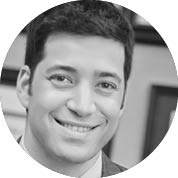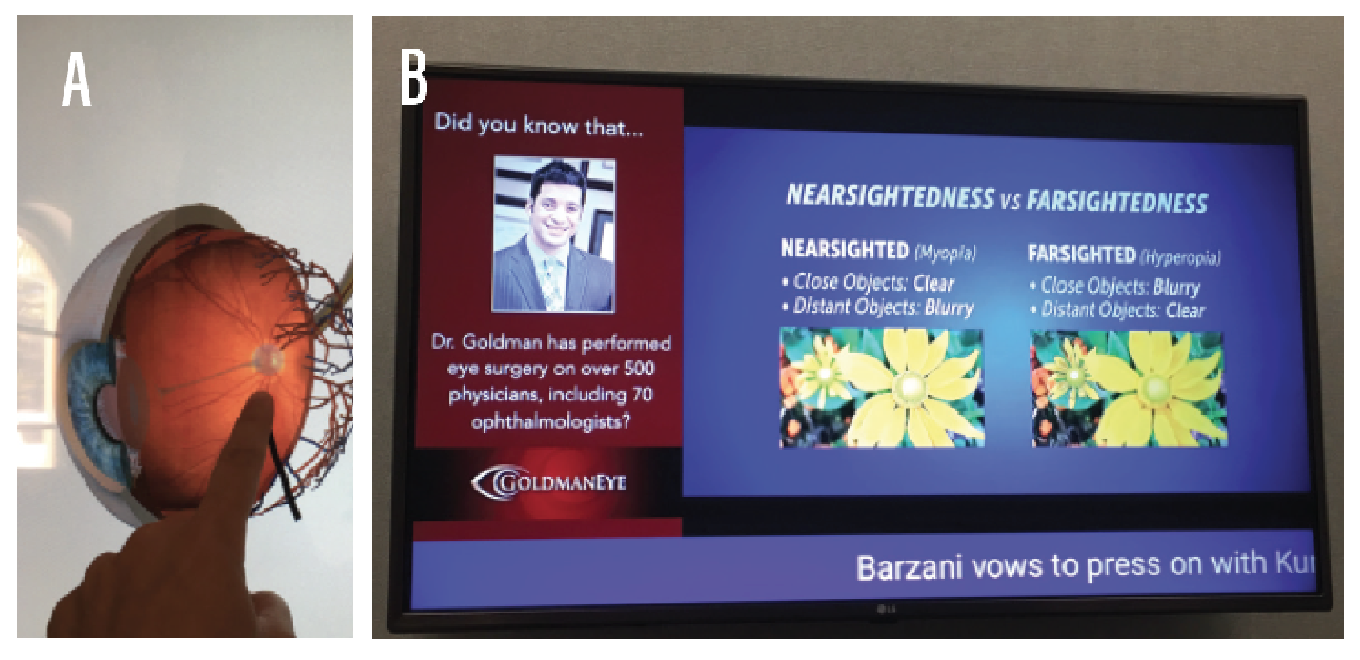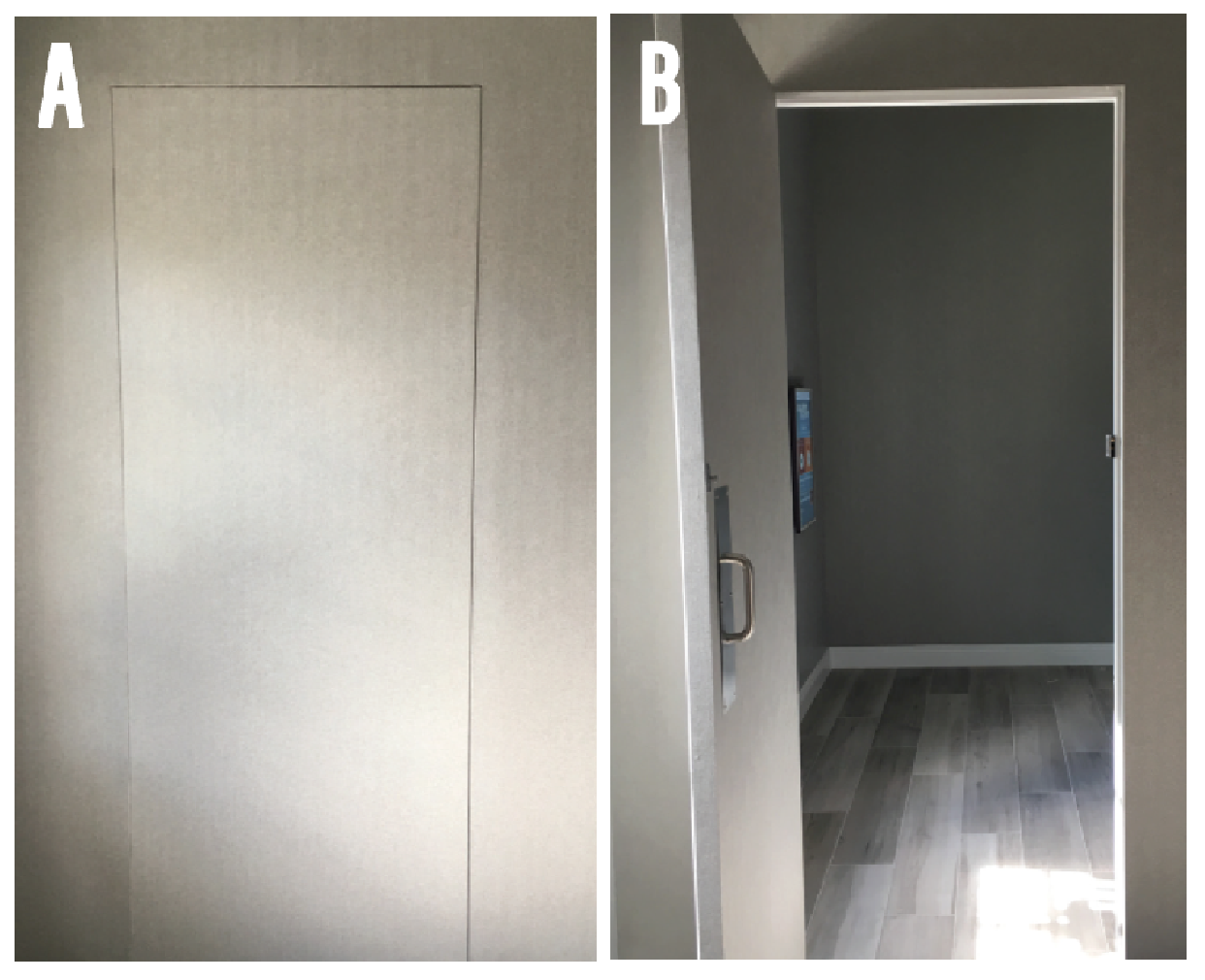Last year, when his ophthalmic surgery practice outgrew the space he was leasing in a medical arts building, David Goldman, MD, faced the fact that his only viable options were to lease a larger high-priced space in the same building or to purchase land nearby and build a new location from the ground up. He ran the numbers and realized that he would get more bang for his buck and plenty of room for future expansion by moving forward with new construction. Today, the new building in Palm Beach Gardens, Florida, houses what is essentially Goldman Eye 2.0—a bigger, better, standalone version of its first iteration (Figure 1).

Figure 1 | The opening of Goldman Eye 2.0.
Dr. Goldman explains that the upgrade was basically a logistical step to address a practical need. “We had to move to a larger space, and there’s not a lot of office space available that is zoned for medical use in the area where I practice,” he says. “When I got a quote for a larger space in the same building, it was going to cost me almost the same to buy the land and build a building with a 20-year fixed-rate mortgage. Plus, I’d have more square footage if I built my own space.” An internist who rented space in the same building and was experiencing similar growing pains joined forces with Dr. Goldman. Now, they each occupy half of the building and share the mortgage.
All of the equipment and office peripherals were slated to be moved to the new location in time for a grand opening in early September 2017, which turned out to be the same week that Hurricane Irma blew through Florida, wreaking havoc in nearby communities. Luckily, the new Goldman Eye building was spared the storm’s effects, and the opening was delayed by just 1 week. Dr. Goldman recalls that he had to reschedule 31 surgeries because of the storm. At first, he viewed the delay as a setback, but it did not take long for him to see the silver lining. “I took a step back and thought, wow, I have 31 surgeries scheduled in a single day, and it’s off-season down here in Florida,” he says. “That’s a testament to how much the practice has grown and what a success it is.”
Dr. Goldman started his career at Bascom Palmer Eye Institute, where he quickly earned a reputation as a highly skilled, high-volume surgeon. After 5 years in academia, he went out on his own and relished the flexibility and autonomy of solo practice, although he acknowledges that his association with one of the most prestigious ophthalmic programs in the country helped him flourish in private practice and develop a winning strategy. “I’ve been very fortunate that, in my career, I’ve been able to travel around the country lecturing on various topics, whether for academic purposes or for industry talks, and I’ve been able to see a lot of top-of-the-line practices and glean from them the aspects that I thought separated them from traditional ophthalmology practices and apply those lessons to my own practice philosophy and business plan,” Dr. Goldman says.
A commitment to excellent outcomes fuels Goldman Eye, and using the best equipment helps achieve those outcomes. Running a tight operation with an emphasis on next-generation technology enables the practice to function optimally with a small well-trained staff. In this article, Dr. Goldman shares his winning philosophy on equipment, information technology, digital initiatives, smart staffing, and office design. He relies on the best of everything to maximize results and stresses that providing patients with “good enough” outcomes will never be good enough for him when better results are possible.
Why is it so important for you to have the best equipment and technology?

DG: There have been a lot of recent changes in health care, specifically with electronic medical record (EMR) integration and, more recently, with the Merit-Based Incentive Payment System (MIPS) and Medicare Access and CHIP Reauthorization Act (MACRA). I wanted to make sure that we had an office that would account for all of that.
We aimed to have a next-gen practice with the most advanced technology available. We tried to get the best in every single class. All of the equipment we have is integrated to function seamlessly with EMR. Our most recent acquisition is the Alcon Contoura Vision package with the »EX500 and »FS200, so we can do topography-guided LASIK in the office.
How is your EMR system integral to your practice?
DG: With the cloud-based »EMA Ophthalmology EMR system (Modernizing Medicine), everything is automated, even from a compliance standpoint. For example, we went from Meaningful Use Stage 1 to Stage 2 and then Stage 3, and now, we’re going to MIPS and MACRA. The list of what the government wants us to report continually changes. Because EMA Ophthalmology is a cloud-based system, it automatically updates in response to what the government requires. I don’t have to change anything; the system will prompt me to enter that necessary information without my having to worry about meeting certain criteria. It helps us get the maximum compensation down the road, which I think is an additive benefit that not enough practices follow through on. It helps me sleep well at night knowing that the numbers I’m reporting are accurate and thorough, because certainly, with this latest round of government reporting, it’s going to affect compensation with Medicare patients, and, in my practice, that’s the majority of my patients.
For instance, when I would attest to Meaningful Use and Physician Quality Reporting System (PQRS), the EMR system automatically accounted for all the factors that I had to submit. It was a 5-minute process that was a matter of clicking a few buttons, and everything went off without a hitch. In fact, we actually got audited on one of the PQRS items and passed with no problem. Going forward with MIPS and MACRA, there are many more factors involved and much more information that must be reported, so having that EMR system will be extremely helpful and will enable us to minimize staffing significantly, which represents significant cost savings.
What are some other advanced digital initiatives at Goldman Eye?
DG: We have an advanced phone networking system that allows us to intercom with other phones; also, when patients leave a voicemail, it shows up as an MP3 file on the computer that we can play without having to dial into voicemail. If someone faxes documents to us, we no longer have to scan them in; every fax form automatically comes in as a PDF file, so we can electronically attach it to the patient’s chart. We also have digital kiosks for patients to check in; everything is networked. Digital wallboards from CheckedUp and Outcome Health in the exam rooms provide a very high-tech and aesthetically pleasing way to educate patients on their ocular disease (Figure 2).

Figure 2 | Outcome Health digital wallboard (A) and Outcome Health TV (B).
We also have two superfast Internet systems: We have both cable and fiber coming into the building, so if there’s ever an Internet outage, we’ve got a backup Internet provider. By taking the belt-and-suspenders approach with both cable and fiber, we are prepared for anything that might cause an outage. We depend on the Internet for our cloud-based EMR system; without it, we’d be stuck.
Are you still able to function with a lean staff in the larger space?
DG: Absolutely. I built with the expectation to grow into the space. The office has 12 exam lanes, but only eight outfitted from day 1. Then, as we grow, we’ll outfit the others. That staged approach helps curb costs. We’re also able to function effectively with a lean staff because of our automated practice management and EMR systems. Personnel are the number-one cost of running a business. Everything that you can automate will lower overhead, even if it means more capital expense. I still have no true practice manager, no true biller; that’s all automated through the EMR and practice management system.
In addition to our technicians, we have an optometrist, who plays a complementary role to mine by treating medical patients and seeing my postoperative patients. With the new office, I’ll probably look to bring on more people, but it’s like a marriage. You have to make sure you get the right person, the right fit. If it means waiting a year or several years to find the right match, I’m fine with that.
Describe one of the innovative design elements that enables you to use space efficiently in the new building.
DG: Lots of people advised me to build a larger building than I needed because expanding later isn’t always feasible. I have more space in the new building than I need. That being said, we still want to run lean and not waste space. For example, IOL clinical studies require a 20-foot lane, but we didn’t want to dedicate 20 feet of space to one exam room. We got around that by having two 10 x 10-foot rooms next to each other with a hidden door in the wall that opens up to provide a 20-foot lane to accommodate the IOL study protocols (Figure 3).

Figure 3 | A 10 x 10-foot room with a hidden door (A). Opening the door creates a 20-foot lane (B).
Do you have any investors in your new practice?
DG: I do not have investors. It’s just me. “I don’t like to gamble, but if there’s one thing I’m willing to bet on, it’s myself.” That’s a Beyoncé quote, and when I heard it, I thought she nailed it. That’s how I feel about this new practice. I don’t know much about the stock market. I don’t know much about 401(k)s or 529s or any of those things, but I know that I was able to single-handedly build an ophthalmology practice successfully. I feel like I can do this 2.0 version just as well.
You’re only 41. Did you expect to be at this stage of your career by now?
DG: Actually, I never even thought I’d start my own practice, and then, fast forward, I never ever thought it was going to get to this level. This new building was something totally out of left field. If you had told me 10 years ago that this is where I’d be at this point in my career, I’d have said, “No way.” It’s definitely much better than I could have ever dreamed.
What motivates you to invest so much in your practice environment?
DG: I look at it this way: People who live in places such as Los Angeles spend a lot of money on their cars because they spend a lot of time in them due to traffic. We doctors spend most of our time in the office, so I think it should look and feel like a nice place to be. I feel the same about the people I hire or any future partners. These are people I’ll share a considerable amount of time with, so they should be people I like. It should be a good fit. When people like each other and you have a happy and healthy environment, it just makes everything better. My staff and I all actually enjoy coming to the office, and everyone takes pride in the work we accomplish.
Dr. Goldman is a consultant to Alcon, Allergan, Bausch + Lomb, Modernizing Medicine, Optos, Shire, Stroma, and Sun Pharma.


